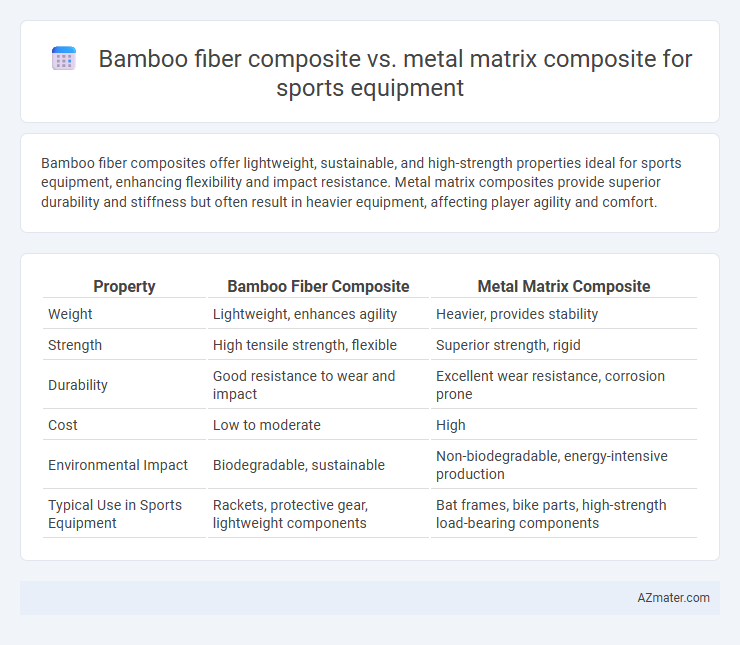Bamboo fiber composites offer lightweight, sustainable, and high-strength properties ideal for sports equipment, enhancing flexibility and impact resistance. Metal matrix composites provide superior durability and stiffness but often result in heavier equipment, affecting player agility and comfort.
Table of Comparison
| Property | Bamboo Fiber Composite | Metal Matrix Composite |
|---|---|---|
| Weight | Lightweight, enhances agility | Heavier, provides stability |
| Strength | High tensile strength, flexible | Superior strength, rigid |
| Durability | Good resistance to wear and impact | Excellent wear resistance, corrosion prone |
| Cost | Low to moderate | High |
| Environmental Impact | Biodegradable, sustainable | Non-biodegradable, energy-intensive production |
| Typical Use in Sports Equipment | Rackets, protective gear, lightweight components | Bat frames, bike parts, high-strength load-bearing components |
Introduction to Composite Materials in Sports Equipment
Bamboo fiber composite offers lightweight and sustainable advantages with high tensile strength and flexibility, making it ideal for sports equipment requiring shock absorption and durability. Metal matrix composites provide superior stiffness, wear resistance, and thermal stability, often used in high-performance applications such as bicycle frames and golf club shafts. The choice between bamboo fiber and metal matrix composites depends on the specific performance requirements, weight considerations, and environmental impact of the sports equipment.
Overview of Bamboo Fiber Composites
Bamboo fiber composites are gaining traction in sports equipment manufacturing due to their high strength-to-weight ratio and sustainability compared to traditional metal matrix composites. These composites offer excellent flexibility, impact resistance, and natural damping properties, making them ideal for applications like tennis rackets, bicycles, and protective gear. Bamboo fibers are biodegradable, renewable, and reduce the carbon footprint, contrasting with the higher weight and environmental impact associated with metal matrix composites.
Overview of Metal Matrix Composites
Metal Matrix Composites (MMCs) consist of a metal matrix reinforced with materials like ceramics or fibers to enhance mechanical properties such as strength, stiffness, and wear resistance, making them ideal for high-performance sports equipment. MMCs provide superior thermal conductivity and lighter weight compared to traditional metals, improving durability and performance in applications like bicycle frames, golf clubs, and tennis rackets. The combination of aluminum or titanium matrices with ceramic reinforcements offers enhanced impact resistance and fatigue life, outperforming conventional materials and certain natural fiber composites like bamboo fiber composites in demanding sports environments.
Mechanical Properties Comparison
Bamboo fiber composites exhibit high tensile strength, excellent impact resistance, and superior flexibility, making them ideal for lightweight and durable sports equipment. Metal matrix composites provide greater hardness, higher stiffness, and enhanced thermal conductivity but tend to be heavier, affecting agility in sports applications. The mechanical advantage of bamboo fiber composites lies in their favorable strength-to-weight ratio, while metal matrix composites excel in wear resistance and structural rigidity.
Weight and Performance Implications
Bamboo fiber composites offer significantly lower weight compared to metal matrix composites, enhancing agility and reducing fatigue in sports equipment. The natural vibration damping properties of bamboo fibers improve shock absorption and comfort, while metal matrix composites provide superior strength and stiffness but at the cost of increased weight. Choosing bamboo fiber composites optimizes performance by balancing lightweight design with adequate durability, especially crucial for dynamic sports like tennis and cycling.
Durability and Impact Resistance
Bamboo fiber composites exhibit high impact resistance due to their natural tensile strength and flexibility, making them ideal for sports equipment requiring shock absorption. Metal matrix composites offer superior durability with excellent wear resistance and structural stability under extreme conditions, enhancing the lifespan of sports gear. Comparing the two, bamboo fiber composites provide lightweight resilience while metal matrix composites deliver robust durability and long-term performance.
Environmental Sustainability and Biodegradability
Bamboo fiber composites offer superior environmental sustainability compared to metal matrix composites due to their renewable sourcing and lower carbon footprint during production. Bamboo fibers are naturally biodegradable, facilitating easier disposal and reduced environmental impact after the lifecycle of sports equipment. In contrast, metal matrix composites often involve energy-intensive manufacturing and pose challenges in recycling, leading to longer degradation periods and increased ecological concerns.
Cost-Efficiency and Manufacturing Challenges
Bamboo fiber composites offer cost-efficiency in sports equipment manufacturing through lower raw material costs and reduced energy consumption during processing compared to metal matrix composites, which require expensive metal alloys and energy-intensive fabrication techniques like powder metallurgy or casting. Manufacturing challenges for bamboo fiber composites include ensuring consistent fiber quality, moisture sensitivity, and achieving strong fiber-matrix adhesion, whereas metal matrix composites face difficulties with high-temperature processing, complex alloying, and tool wear. The eco-friendly nature and ease of scalable processing make bamboo fiber composites a competitive alternative to metal matrix composites despite their lower mechanical strength in certain high-impact applications.
Popular Applications in Sports Equipment
Bamboo fiber composites are widely used in sports equipment such as tennis rackets, skateboard decks, and bicycle frames due to their lightweight properties, high flexibility, and eco-friendly nature. Metal matrix composites dominate applications requiring extreme strength and durability, including golf club heads, baseball bats, and high-performance bicycle components, benefiting from superior stiffness and impact resistance. The choice between bamboo fiber and metal matrix composites hinges on balancing weight, sustainability, and mechanical performance tailored for specific sports equipment demands.
Future Trends and Innovations
Bamboo fiber composite in sports equipment is gaining momentum due to its sustainability, lightweight properties, and high tensile strength, driving innovations in eco-friendly manufacturing and enhanced athlete performance. Metal matrix composites (MMCs) continue evolving with advancements in nano-reinforcements and hybrid composites, offering superior stiffness, impact resistance, and thermal stability for high-performance applications. Future trends indicate a convergence of bio-based fibers like bamboo with metal matrices to create hybrid composites that optimize durability, weight, and environmental impact in next-generation sports gear.

Infographic: Bamboo fiber composite vs Metal matrix composite for Sports equipment
 azmater.com
azmater.com